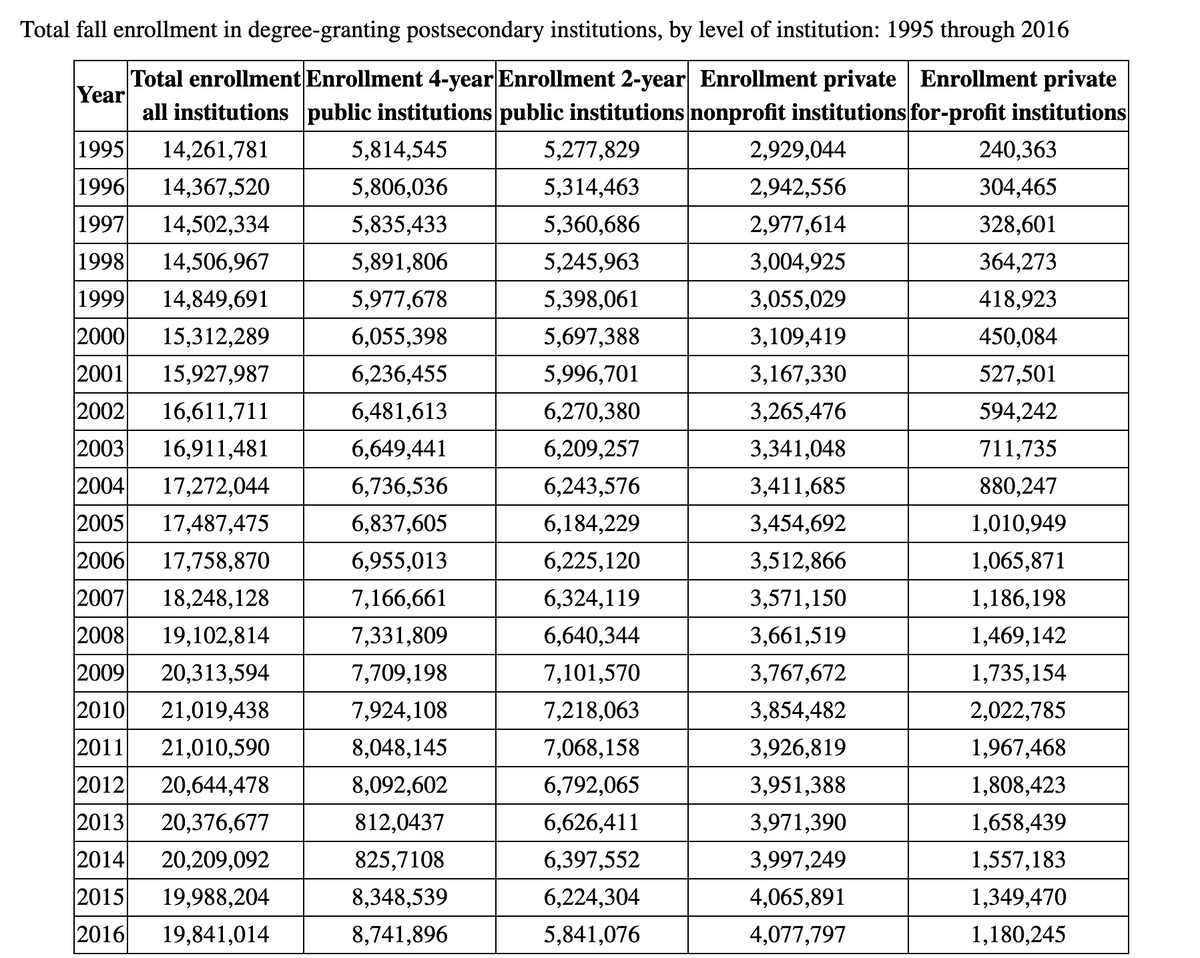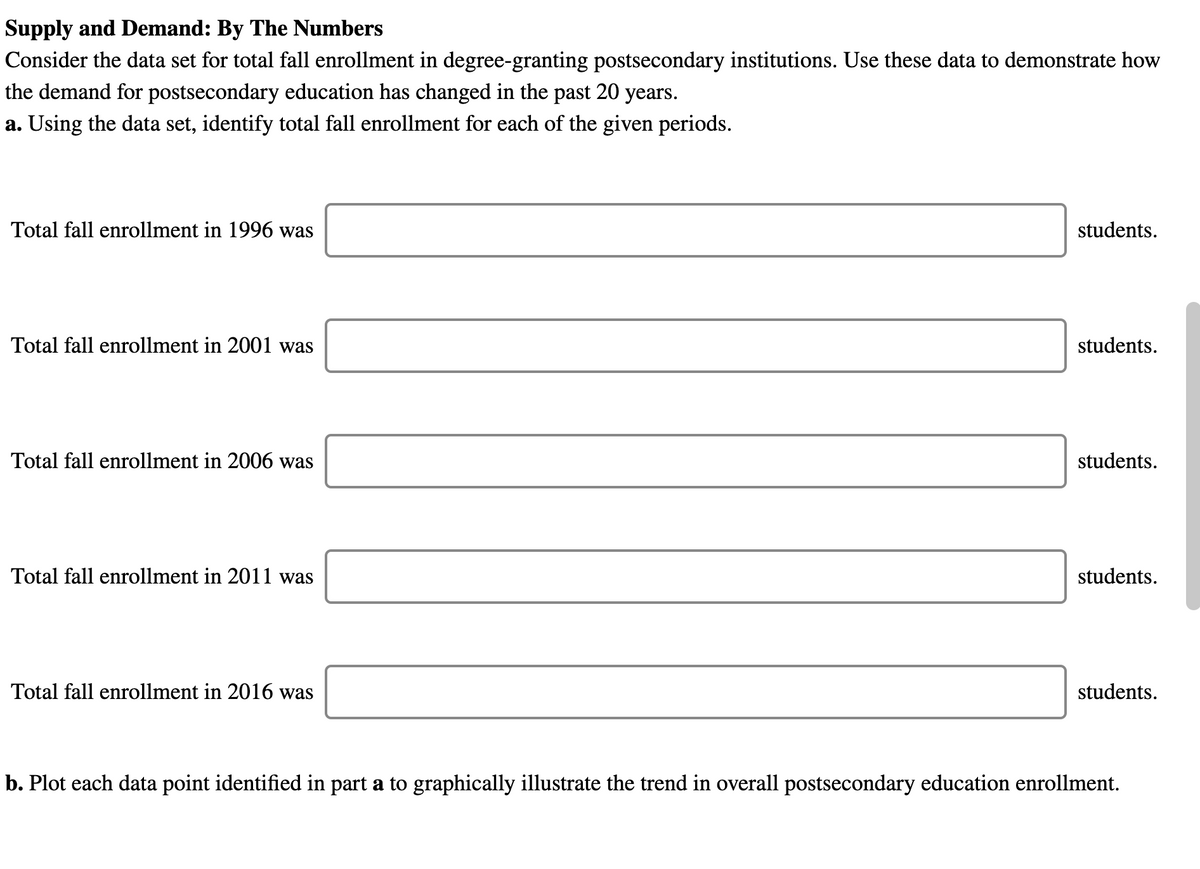Consider the data set for total fall enrollment in degree-granting postsecondary institutions. Use these data to demonstrate how the demand for postsecondary education has changed in the past 20 years. a. Using the data set, identify total fall enrollment for each of the given periods. Total fall enrollment in 1996 was students. Total fall enrollment in 2001 was students. Total fall enrollment in 2006 was students. Total fall enrollment in 2011 was students. Total fall enrollment in 2016 was students. b. Plot each data point identified in part a to graphically illustrate the trend in overall postsecondary education enrollment.
Consider the data set for total fall enrollment in degree-granting postsecondary institutions. Use these data to demonstrate how the demand for postsecondary education has changed in the past 20 years. a. Using the data set, identify total fall enrollment for each of the given periods. Total fall enrollment in 1996 was students. Total fall enrollment in 2001 was students. Total fall enrollment in 2006 was students. Total fall enrollment in 2011 was students. Total fall enrollment in 2016 was students. b. Plot each data point identified in part a to graphically illustrate the trend in overall postsecondary education enrollment.
Managerial Economics: Applications, Strategies and Tactics (MindTap Course List)
14th Edition
ISBN:9781305506381
Author:James R. McGuigan, R. Charles Moyer, Frederick H.deB. Harris
Publisher:James R. McGuigan, R. Charles Moyer, Frederick H.deB. Harris
Chapter7: Production Economics
Section: Chapter Questions
Problem 11E
Related questions
Question

Transcribed Image Text:Total fall enrollment in degree-granting postsecondary institutions, by level of institution: 1995 through 2016
Total enrollment Enrollment 4-year Enrollment 2-year Enrollment private Enrollment private
Year
all institutions public institutions public institutions nonprofit institutions for-profit institutions
|1995
14,261,781
5,814,545
5,277,829
2,929,044
240,363
|1996
14,367,520
5,806,036
5,314,463
2,942,556
304,465
1997
14,502,334
5,835,433
5,360,686
2,977,614
328,601
1998
14,506,967
5,891,806
5,245,963
3,004,925
364,273
1999
14,849,691
5,977,678
5,398,061
3,055,029
418,923
2000
15,312,289
6,055,398
5,697,388
3,109,419
450,084
2001
15,927,987
6,236,455
5,996,701
3,167,330
527,501
2002
16,611,711
6,481,613
6,270,380
3,265,476
594,242
2003
16,911,481
6,649,441
6,209,257
3,341,048
711,735
2004
17,272,044
6,736,536
6,243,576
3,411,685
880,247
2005
17,487,475
6,837,605
6,184,229
3,454,692
1,010,949
2006
17,758,870
6,955,013
6,225,120
3,512,866
1,065,871
2007
18,248,128
7,166,661
6,324,119
3,571,150
1,186,198
2008
19,102,814
7,331,809
6,640,344
3,661,519
1,469,142
2009
20,313,594
7,709,198
7,101,570
3,767,672
1,735,154
2010
21,019,438
7,924,108
7,218,063
3,854,482
2,022,785
2011
21,010,590
8,048,145
7,068,158
3,926,819
1,967,468
2012
20,644,478
8,092,602
6,792,065
3,951,388
1,808,423
2013
20,376,677
812,0437
6,626,411
3,971,390
1,658,439
2014
20,209,092
825,7108
6,397,552
3,997,249
1,557,183
2015
19,988,204
8,348,539
6,224,304
4,065,891
1,349,470
2016
19,841,014
8,741,896
5,841,076
4,077,797
1,180,245

Transcribed Image Text:Supply and Demand: By The Numbers
Consider the data set for total fall enrollment in degree-granting postsecondary institutions. Use these data to demonstrate how
the demand for postsecondary education has changed in the past 20 years.
a. Using the data set, identify total fall enrollment for each of the given periods.
Total fall enrollment in 1996 was
students.
Total fall enrollment in 2001 was
students.
Total fall enrollment in 2006 was
students.
Total fall enrollment in 2011 was
students.
Total fall enrollment in 2016 was
students.
b. Plot each data point identified in part a to graphically illustrate the trend in overall postsecondary education enrollment.
Expert Solution
This question has been solved!
Explore an expertly crafted, step-by-step solution for a thorough understanding of key concepts.
This is a popular solution!
Trending now
This is a popular solution!
Step by step
Solved in 3 steps with 1 images

Knowledge Booster
Learn more about
Need a deep-dive on the concept behind this application? Look no further. Learn more about this topic, economics and related others by exploring similar questions and additional content below.Recommended textbooks for you

Managerial Economics: Applications, Strategies an…
Economics
ISBN:
9781305506381
Author:
James R. McGuigan, R. Charles Moyer, Frederick H.deB. Harris
Publisher:
Cengage Learning



Managerial Economics: Applications, Strategies an…
Economics
ISBN:
9781305506381
Author:
James R. McGuigan, R. Charles Moyer, Frederick H.deB. Harris
Publisher:
Cengage Learning

